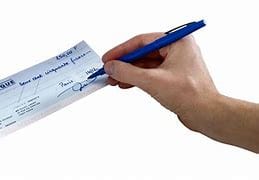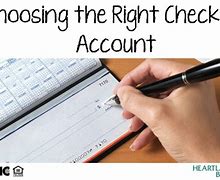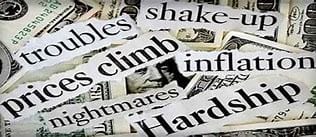Choosing the Right Checking Account


Oke, coba ini untuk paragraf pembuka Anda tentang “Memilih Rekening Giro yang Tepat”:
Choosing the right checking account can feel like navigating a maze, especially when you’re met with an overwhelming array of options. But don’t worry, you’re not alone. Many people find themselves lost in the sea of fees, interest rates, and perks offered by different banks. The truth is, the perfect checking account doesn’t exist. It’s more about finding the one that perfectly aligns with your needs and financial goals.
Think of your checking account like a tool – one that needs to be well-suited for the specific tasks you intend to use it for. Are you a seasoned spender? A savvy saver? Or are you just starting out on your financial journey? Your answers will guide you toward the features and functionalities that matter most to you.
For instance, a checking account that comes with a high interest rate might sound enticing , but it could also be a bit of a trap. It may be filled with hidden fees and charges, so what seems like a winning offer could turn out to be a costly mistake. This is why understanding your needs and identifying the must-have features is paramount.
Let’s be clear, a checking account isn’t just about holding your cash. It’s a platform for managing your day-to-day finances, a key to achieving your financial aspirations. In the following paragraphs, we’ll walk you through the essential factors to consider while choosing the best checking account for your unique situation, leaving you equipped and empowered to navigate this maze and emerge victorious!
Choosing the Right Checking Account: A Comprehensive Guide
In the modern financial landscape, a checking account is an essential tool for managing your money. It allows you to deposit, withdraw, and transfer funds easily, making it a crucial component of your daily financial life. But with so many checking accounts available, choosing the right one can be overwhelming. This comprehensive guide will help you understand the different types of checking accounts, factors to consider, and tips for choosing the best checking account for your needs.
What is a Checking Account?
A checking account, also known as a bank account, is a transactional account that allows you to deposit and withdraw funds as needed. You can access your money through checks, debit cards, ATM withdrawals, and electronic transfers. Checking accounts are designed for everyday transactions and are generally more liquid than savings accounts.
How Does a Checking Account Work?
A checking account works by allowing you to deposit funds into it. You can then use various methods to access your money:
- Checks: You can write checks to pay for goods and services.
- Debit Card: You can use your debit card to make purchases at stores or online, or withdraw cash from ATMs.
- ATM Withdrawals: You can withdraw cash from your checking account using an ATM.
- Electronic Transfers: You can transfer funds to other accounts or pay bills electronically.
Types of Checking Accounts
Checking accounts come in various forms, each catering to different needs and financial situations:
- Basic Checking Accounts: These are the most common type of checking account and often have low or no monthly maintenance fees. However, they usually don’t offer interest or other perks.
- Interest-Bearing Checking Accounts: These accounts offer a small interest rate on your balance, allowing your money to grow slightly over time. However, they may have higher minimum balance requirements or monthly fees.
- High-Yield Checking Accounts: These accounts offer higher interest rates than traditional checking accounts, but they often come with stricter requirements, like minimum balance thresholds or limits on transactions.
- Student Checking Accounts: These accounts are specifically designed for students and may offer special features like lower fees, overdraft protection, or bonus rewards.
- Joint Checking Accounts: These accounts are held by two or more individuals, allowing them to share access to the funds. This can be useful for couples, roommates, or family members.
Why You Need a Checking Account
A checking account is essential for managing your finances effectively. Here are some key reasons why you need one:
- Daily Expenses: You can easily pay for everyday expenses like groceries, utilities, and transportation.
- Direct Deposit: You can receive your paycheck or other income directly into your checking account, eliminating the need for manual deposits.
- Online Bill Payments: You can pay your bills online quickly and conveniently, saving time and postage.
- Receiving Payments: You can receive payments from others through electronic transfers or check deposits.
- Building Credit: Some checking accounts can help you build credit by reporting your activity to credit bureaus.
- Savings Goals: You can use your checking account as a stepping stone to your savings goals by transferring funds to a savings account regularly.
Factors to Consider When Choosing a Checking Account
When choosing a checking account, several important factors should be considered:
Fees and Charges:
- Monthly Maintenance Fees: These are recurring fees charged for maintaining the account.
- ATM Fees: These fees are charged for withdrawing money from ATMs, especially those outside your bank’s network.
- Overdraft Fees: These fees are charged when you spend more money than you have in your account.
- Out-of-Network ATM Fees: These fees are charged for using ATMs that are not part of your bank’s network.
- Minimum Balance Requirements: Some accounts require a minimum balance to avoid monthly fees.
- Transaction Fees: Some banks charge fees for certain types of transactions, such as depositing checks or transferring money.
Features and Services:
- Mobile Banking: Allows you to manage your account on your phone, including checking balances, transferring funds, and paying bills.
- Online Banking: Provides access to your account online, enabling you to manage your finances from any computer with an internet connection.
- Bill Pay: Allows you to pay bills online directly from your checking account.
- Mobile Check Deposit: Enables you to deposit checks using your smartphone.
- Debit Card: Provides a convenient way to make purchases and withdraw cash.
- Overdraft Protection: Protects you from overdraft fees by transferring funds from a linked savings account or credit card.
- Direct Deposit: Allows you to receive your paycheck or other income directly into your account.
- Customer Service: The bank’s customer service should be reliable and responsive.
- Branch Locations: If you prefer in-person banking, consider the number and accessibility of branches in your area.
Interest Rates:
- If you’re looking for an interest-bearing checking account, compare interest rates offered by different banks.
Banking Experience:
- Online-Only Banks: These banks operate solely online and may offer lower fees and higher interest rates. However, you won’t have access to physical branches.
- Brick-and-Mortar Banks: These banks have a physical presence and offer a more traditional banking experience. However, they may have higher fees.
- Credit Unions: These are member-owned financial institutions that often offer lower fees and higher interest rates than traditional banks.
- Community Banks: These are smaller, locally-owned banks that may provide more personalized customer service.
How to Compare Checking Accounts
Once you understand the different types of checking accounts and the factors to consider, you can start comparing options. Here are some tips:
- Use Online Comparison Tools: Many websites allow you to compare checking accounts from different banks based on your criteria.
- Check Bank Websites: Visit the websites of banks you’re interested in to learn more about their checking account offerings.
- Read Reviews: Read reviews from other customers to get insights into their experiences with different banks.
- Talk to Friends and Family: Ask your friends and family for recommendations based on their personal experiences.
Tips for Choosing the Best Checking Account
Here are some additional tips to help you choose the best checking account for your needs:
Assess Your Needs:
- How many transactions do you make each month? If you make frequent transactions, choose an account with low or no transaction fees.
- Do you need a debit card? If you use a debit card regularly, make sure the account offers one.
- Do you need access to a physical branch? If you prefer in-person banking, choose a bank with convenient branch locations.
- Are you comfortable with online banking? If you prefer online banking, choose a bank with a user-friendly online platform.
Read the Fine Print:
- Pay close attention to fees and conditions. Understand all the fees associated with the account.
- Understand the minimum balance requirements. Make sure you can meet the minimum balance requirements to avoid fees.
Consider Your Banking Habits:
- How often do you use ATMs? If you use ATMs frequently, choose an account with low or no ATM fees.
- Do you prefer online or in-person banking? Choose a bank that aligns with your preferred banking method.
- Do you have a good credit history? If you have a good credit history, you may be eligible for special checking account offers or perks.
Conclusion
Choosing the right checking account is an important decision that can impact your financial well-being. By considering your needs, comparing options, and reading the fine print, you can find the perfect checking account to meet your banking needs. Remember to review your account regularly and make changes as your financial situation evolves to ensure you’re getting the most out of your banking experience.


